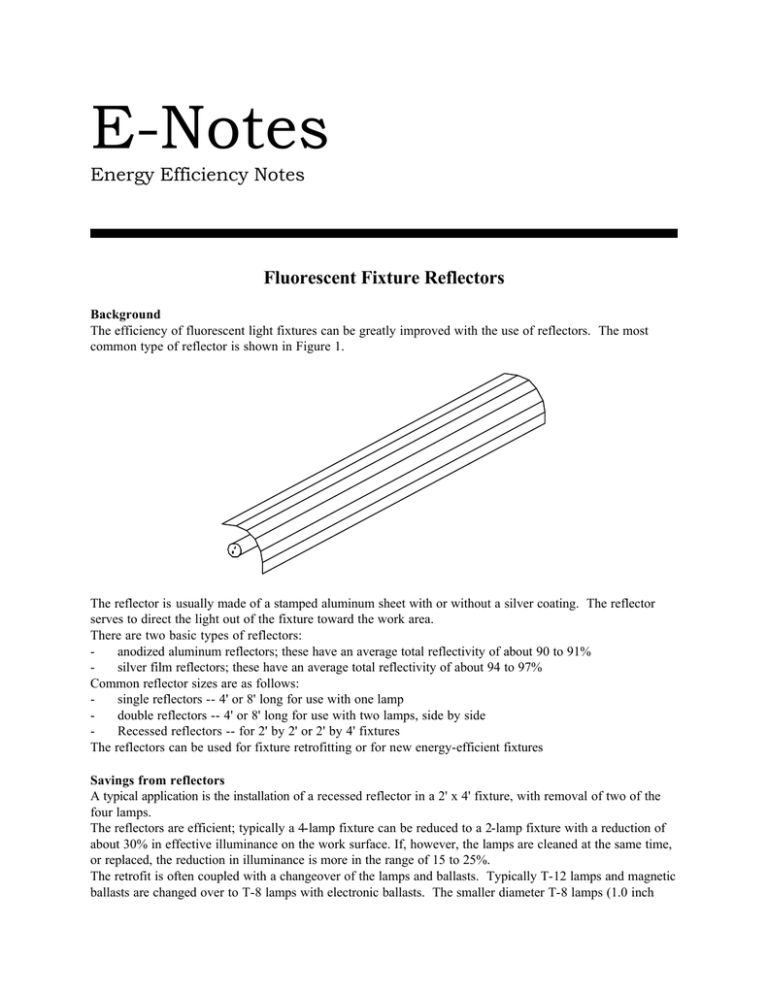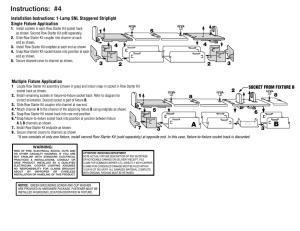Fluorescent Fixture Reflectors
advertisement

E-Notes Energy Efficiency Notes Fluorescent Fixture Reflectors Background The efficiency of fluorescent light fixtures can be greatly improved with the use of reflectors. The most common type of reflector is shown in Figure 1. The reflector is usually made of a stamped aluminum sheet with or without a silver coating. The reflector serves to direct the light out of the fixture toward the work area. There are two basic types of reflectors: anodized aluminum reflectors; these have an average total reflectivity of about 90 to 91% silver film reflectors; these have an average total reflectivity of about 94 to 97% Common reflector sizes are as follows: single reflectors -- 4' or 8' long for use with one lamp double reflectors -- 4' or 8' long for use with two lamps, side by side Recessed reflectors -- for 2' by 2' or 2' by 4' fixtures The reflectors can be used for fixture retrofitting or for new energy-efficient fixtures Savings from reflectors A typical application is the installation of a recessed reflector in a 2' x 4' fixture, with removal of two of the four lamps. The reflectors are efficient; typically a 4-lamp fixture can be reduced to a 2-lamp fixture with a reduction of about 30% in effective illuminance on the work surface. If, however, the lamps are cleaned at the same time, or replaced, the reduction in illuminance is more in the range of 15 to 25%. The retrofit is often coupled with a changeover of the lamps and ballasts. Typically T-12 lamps and magnetic ballasts are changed over to T-8 lamps with electronic ballasts. The smaller diameter T-8 lamps (1.0 inch diameter) tend to work better with reflectors than do the T-12 lamps (1.5 inch diameter). A recent retrofit of a 4-lamp (T-12) 2' by 4' fluorescent fixture with silver reflectors and an electronic ballast was measured to have the following performance: Relative Light Level Relative Energy Consumption 1. Initial illuminance on work surface 824 lux 1.0 1.0 2. Illuminance after silver reflector installed and two lamps removed 580 lux 0.7 0.5 3. Illuminance after two T-8 lamps and electronic ballast installed 742 lux 0.9 0.33 The energy consumption of the fixture dropped from 186 watts to 93 watts after the two T-12 lamps were removed. When the T-8 lamps and the electronic ballast were installed, the energy consumption dropped to 62 watts. The greatest saving came from the installation of the silver reflector. The longer that the light fixture is energized, the shorter will be the payback period. A retrofit of a 4-lamp T-12 4' fluorescent fixture to a 2-lamp T-8 fixture with a reflector would cost about $80 per fixture including labour. The annual energy savings would amount to $30, for a simple payback period of 2.7 years with an energy cost of 7 cents per kWh based on 3,500 hours of lamp operation per year (typical office building). Points to watch 1. Silver reflectors, which offer higher reflectivity, are more expensive than anodized aluminum reflectors. In many cases, the extra cost is justified. 2. When reducing the number of lamps in a fixture, the remaining lamps must be repositioned to avoid an asymmetric distribution of light from the fixture. Kits are normally supplied with the reflectors for repositioning the lamps. 3. While any reflective surface will assist somewhat in increasing the fixture efficiency, it is important to choose a reflector that is designed for the specific fixture. Professional help is recommended. 4. Reflectors tend to direct the light in a more concentrated manner. 5. Dust will readily accumulate on an upward-facing reflector. A downward-facing reflector is much more likely to stay free of dust. Reference Lighting Reference Guide, Canadian Electrical Association, 1991, Suite 1600, 1 Westmount Square, Montreal, Quebec, H3Z 2P9 Fax: 514-936-6498; Phone 514-937-6181 C:\WINDOWS\TEMP \E-NOTES.WPD July 9, 1997

